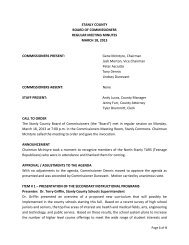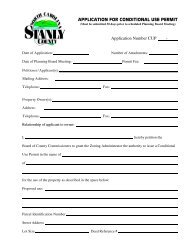Land Use Plan – 2002 - Stanly County, North Carolina
Land Use Plan – 2002 - Stanly County, North Carolina
Land Use Plan – 2002 - Stanly County, North Carolina
Create successful ePaper yourself
Turn your PDF publications into a flip-book with our unique Google optimized e-Paper software.
SECTION 3: THE LAY OF THE LAND<br />
Natural Resources Analysis<br />
STANLY COUNTY<br />
An analysis of environmental conditions within <strong>Stanly</strong> <strong>County</strong> will provide a framework for<br />
decision-making about future development patterns in the county. For a variety of environmental<br />
reasons, certain areas of the planning area are better suited for development than others.<br />
Factors such as soil conditions, lands subject to wetland conditions and flooding, groundwater<br />
supplies, and steep slopes must be considered during the planning process.<br />
The process of determining the suitability of land for development involves analyzing the<br />
attributes of the natural environment and identifying restrictions placed on development by each<br />
attribute. The major natural systems that have been analyzed to determine land suitability and<br />
the county are soils, wetlands, geology, groundwater, surface water, and floodplains. A variety of<br />
sources were utilized in the environmental analysis including the Soil Survey of <strong>Stanly</strong> <strong>County</strong>,<br />
and information obtained from state and federal agency web sites.<br />
Geology of the Region<br />
<strong>Stanly</strong> <strong>County</strong> is located in the Piedmont Province of <strong>North</strong> <strong>Carolina</strong>, between the Blue Ridge<br />
Mountains and the Coastal Plain. The land can be defined as gently rolling. The Uwharrie<br />
Mountain Range, which is considered to be the oldest mountain range in <strong>North</strong> America, is<br />
partially located within the <strong>County</strong>. <strong>North</strong> <strong>Carolina</strong> is divided into nine geological belts, areas with<br />
similar rock types and geologic history. <strong>Stanly</strong> <strong>County</strong> is located within the ‘<strong>Carolina</strong> Slate Belt’<br />
that consists of rock of sedimentary and volcanic origin formed during the Cambrian Period<br />
around 550 to 650 million years ago. When the rock underlying <strong>Stanly</strong> <strong>County</strong> today was formed,<br />
the land was comprised of oceanic volcanic islands.<br />
That geologic history left <strong>Stanly</strong> <strong>County</strong> rich with mineral resources. <strong>Stanly</strong> <strong>County</strong> participated in<br />
the nation’s first “gold rush” beginning in the late 1790s. <strong>North</strong> <strong>Carolina</strong> led the United States in<br />
gold production prior to the gold rush in California in 1849. Some gold mining has continued in<br />
the area to this day.<br />
Today, mineral extraction in the <strong>Carolina</strong> Slate Belt generally consists of surface mining of<br />
crushed stone for streets, and pyrophyllite for refactories, ceramics, filler, paint, and insecticide<br />
carriers. Triassic Period basins containing sedimentary rocks that were formed from streams<br />
carrying mud, silt, sand, and gravel are also found in the county. These mudstones are mined in<br />
order to produce brick, sewer pipe, structural tile, and drainage pipe (<strong>North</strong> <strong>Carolina</strong> Geological<br />
Survey web site).<br />
Soils Soil characteristics play an important role in determining the ability of the land to effectively<br />
support various forms of land use from farming to the construction of a residential subdivision to<br />
more intensive activities such as commercial or industrial development.<br />
There are six general soil units in <strong>Stanly</strong> <strong>County</strong> as shown on Figure 3-1. Each unit usually is<br />
comprised of one or two major series as well as minor series. Table 3-1 provides a summary of<br />
each of the six soil units present in <strong>Stanly</strong> <strong>County</strong>. These units can be used to determine soil<br />
suitability for large areas. Because of the large number of individual soil phases within a general<br />
series—and the widespread availability of soil surveys from various federal, state, and local<br />
agencies—they are not mapped. In order to determine individual property soil suitability the Soil<br />
Survey of <strong>Stanly</strong> <strong>County</strong>, <strong>North</strong> <strong>Carolina</strong> should be consulted (U.S. Department of Agriculture<br />
(USDA), 1997).<br />
<strong>Land</strong> <strong>Use</strong> <strong>Plan</strong> 3-1 6/02






